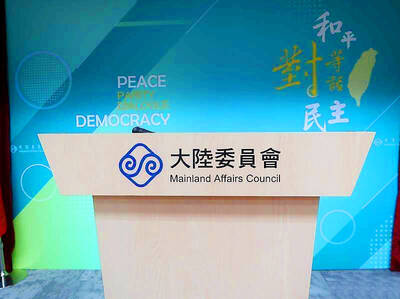Lifelike graphics are breaking free of elite computer games and spreading throughout society in what industry insiders proclaim is the dawning of a “visual computing era.”
Astronauts, filmmakers and celebrities joined software savants, engineers and gamers in the heart of Silicon Valley this week for a first-ever NVision conference devoted to computer imagery advances that change the way people and machines interact.
“Visual computing is transforming the video game industry, transforming the film industry and has all kinds of potential for how we view real-time television,” Nvidia co-founder Huang Jen-hsun (黃仁勳) told those gathered at the event. “We solve some of the most challenging problems for more and more companies around the world. Let the era of visual computing begin.”

PHOTO: AP
Gamers dueled for three days in a cavernous room in the San Jose Convention Center, while entrepreneurs showed how graphics breakthroughs are shining in other fields.
Car makers are exploring letting potential buyers not only customize automobiles with graphics software, but go on virtual test drives.
Graphics processing underpins financial modeling and weather forecasting.
Israel-based Optitex demonstrated software that replicates fabrics so realistically that clothing designers can see what fashions will look and act like on people before the garments are made.
Optitex’s animation software is being eyed by Hollywood film makers.
Dassault Systemes puts 3D computer-assisted design to work virtually constructing passenger jets, buildings and more.
“3D should be a new way for us to dream and design the future of our world,” the French company’s chief executive Bernard Charles said at Nvision. “It will impact everything we do — education, science, talking to each other ... of course games.”
He predicted that lifelike graphics combined with feedback from online communities would let people influence how products are designed, sold and even how “green” they are.
Charles maintained that computer simulations would be so realistic that virtual activities would mirror physical experiences.
Simulators already play an important part in training for space shuttle missions, former US astronaut Eileen Colleens said, the first woman shuttle commander.
“When you fly the actual mission you feel like you are in a simulator,” Collins said. “We really can’t do our job without the good visual graphics that we get.”
Visual computing is “inescapable,” said Chris Malachowsky, a co-founder of Nvidia, a California firm renowned for high-end graphics processing cards for computers.
“We are being presented with displays everywhere,” Malachowsky said. “It used to be about the computing part, but the emphasis is shifting. It is not so much about the computation, but how it is presented and seen by people.”
The rising tide of digital videos, photos, films and television shows on the Internet is lifting the status of graphics chips, cards and software and strengthening a trend to “unflatten” displays with 3D imagery.
Malachowsky spoke of using visual computing power to develop new medicines or provide doctors with real-time 3D images of patients’ organs.
“They will be able to recreate scan data so fast you could see your own heart beating,” Malachowsky said. “This is being subsidized by all these kids out there playing games.”
Perceptive Pixel founder Jeff Han, referred to by some as “the father of touch screen” computing, maintains graphics opens up user interface control possibilities that could render a “mouse” obsolete.
Han demonstrated touch-screen technology that lets several people simultaneously manipulate applications and files on a single large monitor.
“It’s not personal computing anymore,” Han said. “It’s visual computing.”
Battlestar Galactica bombshell Tricia Helfer praised computer animation innovations that enable the science fiction television series to rivet viewers.
Helfer plays a part-machine, part-organic Cylon character called “Number Six” that has turned on its creators.
“It’s a bit threatening,” Helfer said of technology promising to one day make animated characters indistinguishable from real actors. “But the advantages and uses of it are amazing, but it is something we are going to have to get used to.”

MORE VISITORS: The Tourism Administration said that it is seeing positive prospects in its efforts to expand the tourism market in North America and Europe Taiwan has been ranked as the cheapest place in the world to travel to this year, based on a list recommended by NerdWallet. The San Francisco-based personal finance company said that Taiwan topped the list of 16 nations it chose for budget travelers because US tourists do not need visas and travelers can easily have a good meal for less than US$10. A bus ride in Taipei costs just under US$0.50, while subway rides start at US$0.60, the firm said, adding that public transportation in Taiwan is easy to navigate. The firm also called Taiwan a “food lover’s paradise,” citing inexpensive breakfast stalls

TRADE: A mandatory declaration of origin for manufactured goods bound for the US is to take effect on May 7 to block China from exploiting Taiwan’s trade channels All products manufactured in Taiwan and exported to the US must include a signed declaration of origin starting on May 7, the Bureau of Foreign Trade announced yesterday. US President Donald Trump on April 2 imposed a 32 percent tariff on imports from Taiwan, but one week later announced a 90-day pause on its implementation. However, a universal 10 percent tariff was immediately applied to most imports from around the world. On April 12, the Trump administration further exempted computers, smartphones and semiconductors from the new tariffs. In response, President William Lai’s (賴清德) administration has introduced a series of countermeasures to support affected

CROSS-STRAIT: The vast majority of Taiwanese support maintaining the ‘status quo,’ while concern is rising about Beijing’s influence operations More than eight out of 10 Taiwanese reject Beijing’s “one country, two systems” framework for cross-strait relations, according to a survey released by the Mainland Affairs Council (MAC) on Thursday. The MAC’s latest quarterly survey found that 84.4 percent of respondents opposed Beijing’s “one country, two systems” formula for handling cross-strait relations — a figure consistent with past polling. Over the past three years, opposition to the framework has remained high, ranging from a low of 83.6 percent in April 2023 to a peak of 89.6 percent in April last year. In the most recent poll, 82.5 percent also rejected China’s

PLUGGING HOLES: The amendments would bring the legislation in line with systems found in other countries such as Japan and the US, Legislator Chen Kuan-ting said Democratic Progressive Party (DPP) Legislator Chen Kuan-ting (陳冠廷) has proposed amending national security legislation amid a spate of espionage cases. Potential gaps in security vetting procedures for personnel with access to sensitive information prompted him to propose the amendments, which would introduce changes to Article 14 of the Classified National Security Information Protection Act (國家機密保護法), Chen said yesterday. The proposal, which aims to enhance interagency vetting procedures and reduce the risk of classified information leaks, would establish a comprehensive security clearance system in Taiwan, he said. The amendment would require character and loyalty checks for civil servants and intelligence personnel prior to